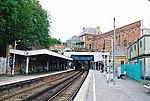Crystal Palace National Sports Centre

The National Sports Centre at Crystal Palace in south London, England is a large sports centre and outdoor athletics stadium. It was opened in 1964 in Crystal Palace Park, close to the site of the former Crystal Palace Exhibition building which had been destroyed by fire in 1936, and is on the same site as the former FA Cup Final venue which was used here between 1895 and 1914. It was one of the five National Sports Centres, run on behalf of Sport England, but responsibility was transferred to the London Development Agency (now GLA Land and Property) and is managed by Greenwich Leisure Limited, under their Better brand logo. The athletics stadium has a capacity of 15,500, which can be increased to 24,000 with temporary seating. It hosts international athletics meetings. As well as sporting events, the stadium has played host to a number of live open air concerts, by artists such as Coldplay, Bruce Springsteen, Sex Pistols and Depeche Mode.
Excerpt from the Wikipedia article Crystal Palace National Sports Centre (License: CC BY-SA 3.0, Authors, Images).Crystal Palace National Sports Centre
Geological strata bridge, London Crystal Palace (London Borough of Bromley)
Geographical coordinates (GPS) Address Nearby Places Show on map
Geographical coordinates (GPS)
| Latitude | Longitude |
|---|---|
| N 51.419083333333 ° | E -0.068805555555556 ° |
Address
Athletics Stadium
Geological strata bridge
SE19 2BB London, Crystal Palace (London Borough of Bromley)
England, United Kingdom
Open on Google Maps











